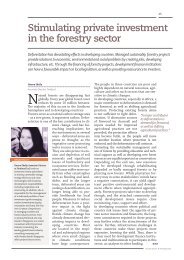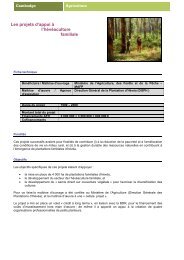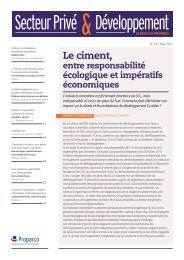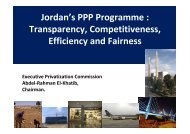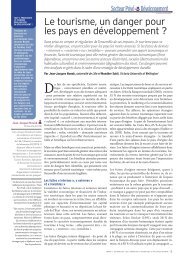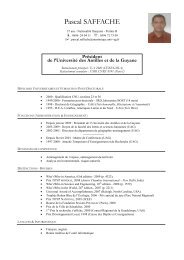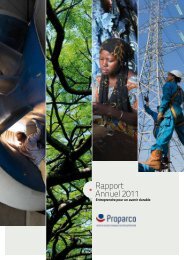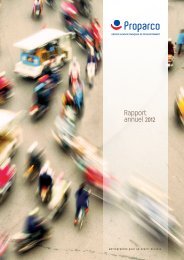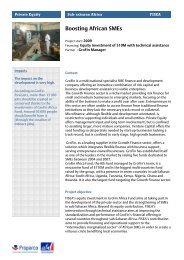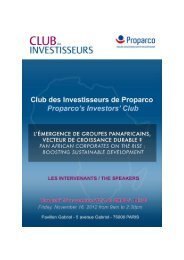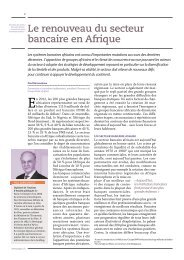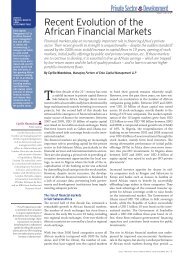Integrating Poor Populations in South African Cities - Agence ...
Integrating Poor Populations in South African Cities - Agence ...
Integrating Poor Populations in South African Cities - Agence ...
You also want an ePaper? Increase the reach of your titles
YUMPU automatically turns print PDFs into web optimized ePapers that Google loves.
2. Current Challenges<br />
However, despite these improvements, <strong>in</strong>equalities have cont<strong>in</strong>ued to grow and<br />
the government is struggl<strong>in</strong>g to reduce them. Economic growth is not spread<strong>in</strong>g as the<br />
government would like, and the gap is widen<strong>in</strong>g between economically <strong>in</strong>tegrated<br />
populations and the poorest. Unemployment is grow<strong>in</strong>g: it was officially 23.08% <strong>in</strong> 1996,<br />
and 24.13% <strong>in</strong> 2004. 26 A large percentage of the <strong>South</strong> <strong>African</strong> population lives <strong>in</strong><br />
extreme poverty: <strong>in</strong> 2005, 52% of the total population was beneath the M<strong>in</strong>imum<br />
Liv<strong>in</strong>g Level. 27<br />
2.1.4. Hous<strong>in</strong>g Challenges<br />
As we saw earlier, a proactive hous<strong>in</strong>g policy has been <strong>in</strong> place s<strong>in</strong>ce 1994, and<br />
has provided a roof to one and a half million households <strong>in</strong> a decade. This programme<br />
rapidly came to be seen as an <strong>in</strong>complete response for several reasons. Offer<strong>in</strong>g<br />
ownership of property to relatively poor households has <strong>in</strong>conveniences as the<br />
households are not necessarily able to regularly pay their house-related expenses<br />
(electricity, water, repairs, upkeep) and are sometimes obliged to sell the property for<br />
very small sums. Indeed, the RDP houses’ architectural uniformity and m<strong>in</strong>imum<br />
comfort did not encourage a true secondary market to emerge, and this lack of<br />
encouragement was further strengthened by the government’s discourse discourag<strong>in</strong>g<br />
resale. Next, as has already been emphasized, rental solutions were not chosen and<br />
do not allow for an alternative offer to meet the diversity of needs. In addition, the subsidy<br />
offered by the government start<strong>in</strong>g <strong>in</strong> 1994 only applies to households earn<strong>in</strong>g less than<br />
3,500 rand per month. Thus, there was no hous<strong>in</strong>g solution for households above this<br />
threshold; these households could neither receive the subsidy nor take out loans from<br />
private banks. This phenomenon is called gap hous<strong>in</strong>g and found a partial solution<br />
through the grow<strong>in</strong>g social <strong>in</strong>volvement of banks and a proportional extension of<br />
government assistance.<br />
53<br />
The limits of this policy and the growth <strong>in</strong> the number of households (population<br />
growth and smaller household size) perpetuated, even worsened, the hous<strong>in</strong>g crisis.<br />
The number of households without formal hous<strong>in</strong>g grew from 1.45 million <strong>in</strong> 1996 to<br />
26. Source: Quantec.<br />
27. Percentage calculated from the State of the <strong>Cities</strong> Report 2006, <strong>South</strong> <strong>African</strong> <strong>Cities</strong> Network.<br />
© AFD 2009 <strong>Integrat<strong>in</strong>g</strong> <strong>Poor</strong> <strong>Populations</strong> <strong>in</strong> <strong>South</strong> <strong>African</strong> <strong>Cities</strong>



